TRANSPORT
In this section I discuss everything transport related other than cars. That you can find here : CARS Shipping is limited to HARBOUR MEMORIES
Wagons & carts
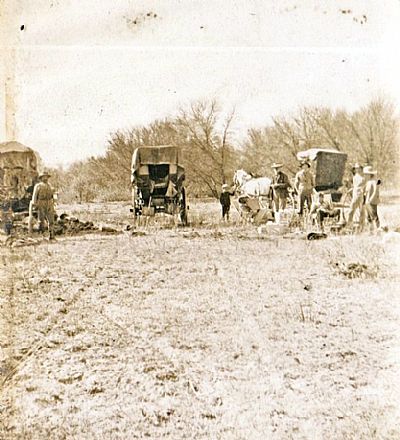
This one is dated 1915
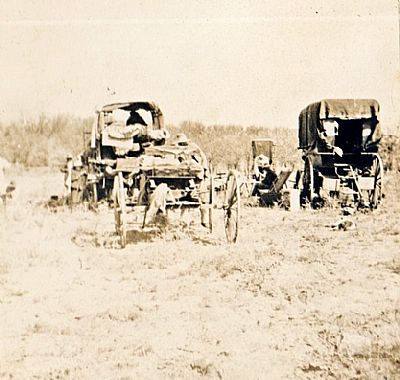
This is dated 1911 and labelled "tennis at Hansa Haus" presumably some social event at the home of a German family.
I cannot tell you very much more about these two photos. What I do know is that the family would set off for ling distance picnics by mule drawn wagons, in these cases to social events on someone's farms, but I remember being told of similar excursions to beaches up the coast. Even getting to a friend's cottage just accross the Quinera River ie opposite Bonza Bay, was such an adventure.
Even while cars were becoming popular, such vehicles still had the benefits of being able to transverse rough wild terrain. It was using such transport including the heavier ox drawn wagons that our ancestors got about the area now knowns as the Eastern Cape.
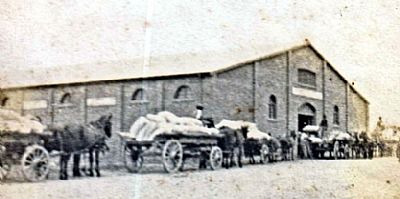
This is an extract from a photo of the premises that were to become Noggs Newman's warehouse business. By the time I knew Noggs his business was thriving and designed new access for lorries, but he could still claim his own railway siding (essential in the earlier years of railway predominant deliveries). But here we see mule drawn wagons with bags of produce lining up. The label notes "Newman + Wilki Newman's Bond Store near the cemetery".
Cycling
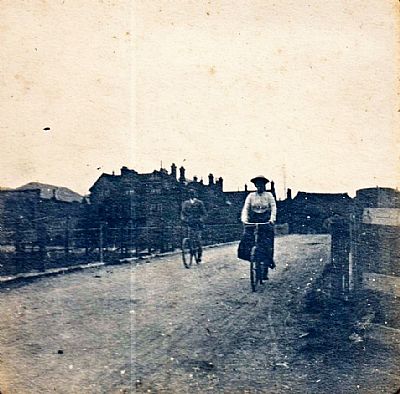
I don't have many picture of cycling, even though it would have been popular with my family, so here is one from England. These are family friends, the Fullers. We are connected to the Fullers through the Newmans, so presumably these are their relatives. Ethel in front in Broadstairs. Anyway, aren't you impressed with the cycling gear? The very reason that women's bikes have a low cross bar. These would have been fixed gear bikes then. It is a flat but rutted road.
Trams
I have reasonably clear memories of travelling on a tram in Johannesburg as a child. I think they had been continued as a tourist attraction as they were well past their practical life. The dual lines of cables still formed a spider web above the city and served the trolley buses too.
Trams had been introduced into Johannesburg in 1891 and ran until 1961. I remember the hard bench seats. If you rode on them until the end of a line, as we did and so did many others just there for the historical experience, you would flip the back of the bench to the other side so that you could do the return trip facing the right way. And attendants would need to change the electrical supply contact rods around too.
Trams were of course the main mode of urban travel worldwide. Remnants of tram tracks still exist below the tarred road surface right here where we live now in Scotland.
I have less clear memories of travelling on a trolley bus, but that would have been the main mode of city centre travel. These looked just like regular buses, but with the same power source from cables strung above the streets.
It is interesting to ponder the role of both trams and trolley buses powered by electricity in this era of electrication of buses and cars (as I write in 2025). The main difference is that the power came in from above, much like electric train engines have today, instead of from onboard batteries.
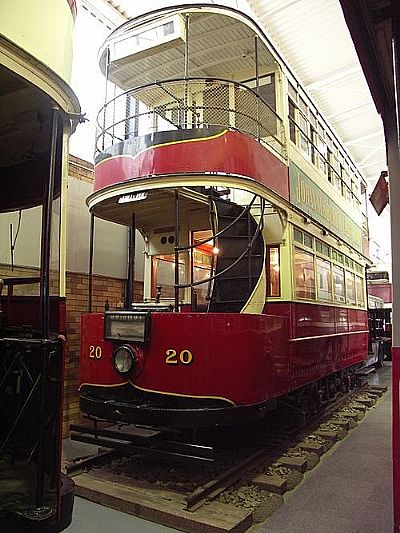
A Wiki image from the Johannesburg transport museum.
We have of course been on trams in Europe. They remain an efficient mode of travel. Those in Lisbon, for instance, are a major tourist attraction. They are relatively small and predate those of Johannesburg by about two decades as a service, several of those still extant restored.
Trains
As kids we would go up to the train track along the edge of Selborne and play there. We would try to outdo each other by jumping from track to track - easier in SA than most other countries as the gauge is not that wide. And we would put nails onto the track to be deformed into interesting shapes by the train wheels.
So much for security then.
My parents didn't seem too bothered either. The only warning my father had was to avoid being mistaken for a political vandal, there having been acts of sabatage elsewhere in the country against the country. That particular track was fairly new having been built to link the harbour with the main line connecting with it nearby. The trains were all diesel and very powerful. Experiments being made with train lengths, the longest reached then being one kilometre. Asd they struggled up from the harbour, the whole earth shuddered. My parents had a pelmet around the original lounge / later the dining room, with decorative items displayed on it. I don't remember breakages, but that is because they were nailed down carefully.
We never did school trips. Well we were taken into the basin of what was to be the Bridle Drift Dam while it was being cleared, by landrover. But that is not the same thing. The closest I got to a school trip was to go to Queenstown by train to play hockey. This was the "milk train". It took all night and stopped regularly to pick up and drop farm supplies.
There was a time when train travel was safe tor white folk. Apartheid separated the races so that they didn't mix. They even had separate entrances and separate trains for the more local runs such as from Mdantsane.
As a white you had access to a waiting room and a porter. Porters pushed large baggage trolleys. Parallel two wheeled see-saw things onto which all the larger bags, mainly from the baggage wagon, were stacked and taken to the receiving room. One could ask forpersonal bags to be taken to a waiting car or taxi for a suitable tip.
Most of the trains were diesel, but many steam engines remained until comparatively late. I saw a lot of SA from steam trains while in the navy. We transversed the country from EL to the Cape or to Durban the long way around Lesotho by train. To escape the smoking within the carriages I would stand at an open window - only to have my face blackened by soot if the wind was in the wrong direction. But those old trains were elegant. Very dignified old hardwood panelled dining cars. Proper food. Soup in bowls edged to deal with the sway of the train.
The sleeper cars had fold-down bunk beds with dark green leather upholstery (I think first class was dark red). The guys being transported with me would cut them up and make nik-naks. Great vandalism. When we snaked slowly through black townships these same guys would heat pennies on cigarette lighters and then throw them to the expectant children who swarmed next to the track.
These were interesting trips. Steam trains emit sparks and falling burning coal. And when they fall onto a parched bushveld fires start. On one trip I counted 7 such fires.
The only really boring part was being stranded in the middle of the shunting yard at night in De Aar, a major connecting centre.
All the larger cities had electric power on their tracks. It took years for East London to catch up and I remember when it did. The process was hardly noticed by most people, but I considered it momentous.
Many little used sidings and shunting yards still had rusting old steam engines years later. The carriages though were generally broken up.
Years later I became very involved in what was called the Sleeper Site in East London. A vast disused area once covered by shunting yard and maintenance facilities. I was able to see the latter before they were demolished. Some had partially restored old carriages. A lot of tools unique to the railways still lay around or hung from the walls. That was all dumped to sold as scrap - against our protestations.
However when I was involved in the restoration of the City Hall in 1989, we found a retired boiler fitter with copper working skills to rebuild the ornate copper spire.
Early airflight
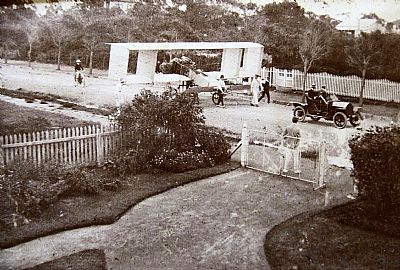
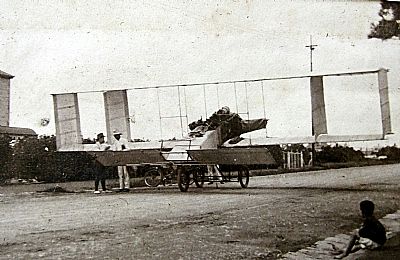
This was the biplane to be demonstrated by Albert Kimmerling - one of the very first powered flights in South Africa. The view is believed to be from the family home in St Peters Road, Southernwood. Quite a sight to see trundling past you garden gate.
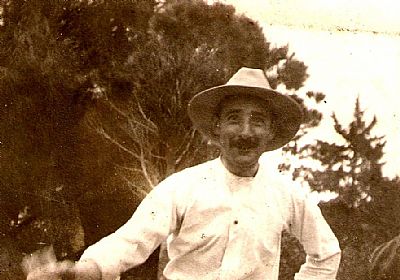
This photograph is amongst my inherited collection (which includes those of the plane above). It is unlabelled, but appears to be of Kimmerling himself. (I have compared it to others where he is usually in a flatcap or flying cap).
We now live not that far away from where early flights were tried in Scotland. These were just outside Cardross by Percy Sinclair Pilcher in 1895. His craft were more like bats and in fact one was called just that, the Bat. By contrast that which trundled through Southerwood that day, was quite sophisticated.

Display in Kelvingrove Museum, Glasgow.
Modern aircraft
Imagine an era within living memory where airflight was unusual. Almost all planes had propellers, but gradually more airlines introduced jet engines. Trips were quicker, but for some time still the preserve of a few. Those who did use these regularly became known as "jet-setters".
It was also a time before the stringent security measures of today. You could ask to see the pilot's area even while flying. On one ocassion my father did so while on a flight up to Durban. The pilot flew low over a house on the Transkei Wild Coast and dropped a newspaper out the window for a friend.
East London's current airport terminal had not yet been built when we were kids. At that time it was still at Collondale at the other end of the runway. This was comprised of old WWII airforce shed. One for passengers and another for luggage. We would go outside to the fence to get close to the stationary aircraft. Corrugated iron sheltered us from the blast when the engines were started. (I remember such a moment in about 1964 with my brother when I confided in him that I had started shaving with our father's shaver. I never confided in him so the atmosphere must have affected me).
SAA introduced jet flights in part due to most African countries denying them landing rights on the long hauls to Europe. They needed aircraft with greater speed and distance capabilities.
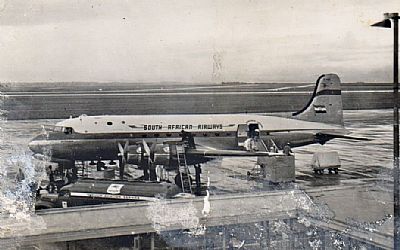
This Viscount was taken by my father at Jan Smuts (Johannesburg) airport on one of his trips in 1954. It does not necessarily mean that he flew on it. (A plane like this crashed into the sea off East London in 1967}.
My father was a friend of Hugh Stocks who lived in or near Johannesburg, but who had a beach cottage in the Port Alfred area. He was a keen small plane pilot and over time owned several planes. On one ocassion he invited us all down to his cottage on his plane.
I was to get another small plane flight years later when I asked someone I knew who was a flight controller at the airport if he could arrange something. I wanted to get air photos of the East London area for my project of M.O.S.S (Metropolitcan Open Space System) that I was doing through the local SA Wildlife and Environment Society.
One of my architect friends did gliding. After hearing some of the reactions of others who had gone up with him, I declined an invite. But I did got up in a microlight owned by a builder friend and felt very safe. It was one of those triangular "kite" shaped craft with an engine at the back. The photos of our house taken from it can be found here. HOME ENVIRONMENT BEACON BAY
Hovercraft
It was while on my trip as a student to Europe that I flew on a hovercraft across the channel. The ferry took about 4 hours; the hovercraft about a 1/4 of that time. While many may think of the crossing as more akin to a ferry trip on a different sort of craft, it really was a flight albeit very close to the sea surface. Complete with air hostesses.
It is a bit eerie flying so close to the water.
These craft are very versatile and are still used around the world for a variety of purposes. The trouble is that without traction on a hard surface or water, they are prone to cross winds and cannot cope well with choppy seas. They were therefore frequently cancelled and eventually dropped from this route altogether.
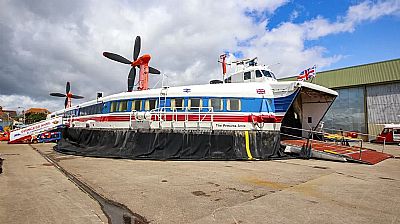 My photos of the hovercraft were amongst those lost on my corrupted hard drive so here is one from the web. You can see the walk-on ramp directly from the slipway, the navigation cockpit, the large propellers and the air skirt.
My photos of the hovercraft were amongst those lost on my corrupted hard drive so here is one from the web. You can see the walk-on ramp directly from the slipway, the navigation cockpit, the large propellers and the air skirt.
Flying stories
Most flights consist of long hours of very little, but here are some memories of flights that stand out for me.
My first flight to the UK was with my parents. It was on a Jumbo arriving at the Heathrow terminal that we saw next to us in the morning gloom, the sleek little Concorde next to us. (Years later on a cruise we heard a talk by one of the last Concorde pilots and met him). This was to be the way forward in intercontinental air travel, but for various reasons got shelved.
Once on a flight to Europe as a student break on my own I sat next to the captain's wife. She sneaked off for a sleep in a spare bunk used by long-haul cabin crew and I was able to stretch out over her seat for a snooze too.
Quite often there were Muslims off to Mecca and so there was on this flight. The first signs of dawn were special to them way up above the clouds and some would set out their prayer rugs in the aisles. She regaled me with stories of earlier flights when one had set up a portable paraffin stove in the aisle to make himself some traditional morning tea after prayers.
On the way back from the same trip I sat next to a girl who had experienced an emergency landing in Amsterdam due to a fire scare. Evidently nothing serious was wrong, but the passengers had to exit at the far end of the runway down the inflatable slides into foam.
I used internal flights quite a bit in later years to get to meetings. There was one when the wind was really strong on the approach to Jan Smuts (Johannesburg) and we came in so low that we could see the grass in detail for some time. After some yawing (a sideways motion), we made a perfect landing amidst clapping.
On another flight to Scotland with the family, we were sitting in the plane waiting to set off and just starting to move when there was a persistent bang bang bang bang. A bit disconcerting. There were some theories amongst the passengers. Then one wise quip suggested that someone was locked in the hold. The plane was stopped. The hold opened. There he was. One of the luggage packers.
These all pale though compared to a story by a distant cousin from England, Another Peter Watson. He was an industrial sales rep dealing with Malaysia. On an overnight flight he looked out to see one of the engines on fire. He called one of the cabin crew. She casually told him that all was in hand. The fuel to that engine had been switched off and the flames and smoke would soon die down.
South Africa had its own airline, SAA, but would link up with others to get use of airspace and refueling stops that may have been restricted for political reasons. The airline that I used as a student was Luxair, part owned by Luxembourg, with a bustling hub airport in its capital city.
On a trip to Scotland with our family we used the Bulgarian airline providing budget flights in tandem with SAA.. Sophia airport was a bit of a mystery. While the pre-flight area was modern, the main holding areas were very shoddy. I was catching up with the family who had flown a few days earlier (I had had to finish some work first) and got into conversation with some young guys from 3 different African countries. All were very disparaging about it. Out of the window we could see some aging aircraft left from the not so distant regional wars. One had a glazed gun turret.
A distant cousin from England told of when he was a trade agent with Malasia. On a flight there he awoke during the early hours to see flames spluttering out of the jet engine. He called for a flight attendant and was calmly told that they already knew about it. The engine had been shut down. They simply waited until the fuel to this engine had burnt off and proceded on the remaining three engines.
Air displays
As a teenager I saw air displays both off the East London shore and at the airfield in Pretoria.
For the East London show we parked the family car in Seaview Terrace much as it was done by the family before us when they lived up there with great views over the sea. (We also saw fireworks display from up there and also the turning on of the Christmas lights). There was the usual variety of impressive planes and some almost vintage ones.
A local pilot would trail advertising and message banners up and down the coast. Another even wrote messages with his vapour trail.
I began to recognise some of the planes and would later see an even more impressive display near the Pretoria airfield while lying across the car bonnet looking up as the planes flew in formation and created patterns in coloured smoke.
Staying lying across the car bonnet was not a good idea when the planes reached and then broke through the sound barrier. The whole shook and one needed to hang on tight, even holding ones ears for the sonic boom. Such sound barrier displays are rare. They tend to break windows, particularly in South Africa where few people have toughened glass. Most people simply feel a little deafened by it for a while. Others may get injured. The pressure created by a sonic boom at such close range could burst eardrums.
The French manufactured Mirage was being promoted as South Africa being on the forefront of air dominance in the region and the Buccaneer made by Blackburn factory. This was a low-level, high-speed, carrier-borne strike aircraft utilized by the British Royal Air Force and its Royal Navy. South Africa became the only foreign operator. It was very pointed at both ends and caught the imagination of us teenagers even more than the Mirage.
I was to see Catalinas, Dakotas and Harvards while I was in the navy and even afterwards. These three iconic planes were in essence, remnants of the WWII days, but still flying in the 1970s. I discuss them here : NAVAL CAREER
Drones
Drones made an amazing difference to all aspects of life... and death.
I was given one by one of my daughters in my '70s. It was not sophisticated, but was an excellent introduction to them. My (then) young grandson liked to play with it and was successful fyling it horizontally into the garden shrubs. I had managed rather better, having flown it high into the dazzle of the sky and into trees. Getting it back was very much coincidence as luck. If it didn't get jammed into the higher branches, it eventually came down again the breeze.
I still have it.
Even when drone became commonly available, the good ones remained expensive. It was quite some time before I saw one besides mine. So it was quite startling to get this small one as a present.
The range that developed over the 2000s is quite extraordinary. In fact tiny ones could pack in the sophistication of the larger ones even if they didn't have the same lifting capacity and wind resitance. Large ones were by this time even being invented to carry people, but these remain rare as I write in 2025 and unknown in the UK.
I twice got friends with sophisticated drones to photograph Carman Hill Fort from the air. See more here: http://www.spanglefish.com/ExploreWestDunbartonshire/index.asp?pageid=715665
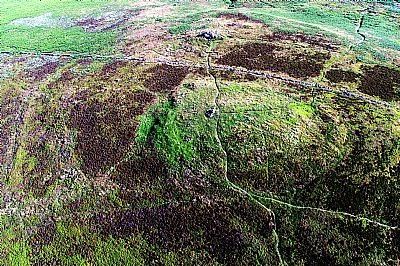
The hillfort on Carman Hill just up the road from where we live. It was taken by others on my behalf. You see the ancient encircling ditches which would have had timber paling and the double row of enormous rocks tumbled into position to the right. The other stone walls are dry stane dykes from the much later era of containing sheep flocks.
I read Alvin Toffler's Future Shock in the 1990s and followed that up with his sequel The Third Wave. In these he describes, amongst other seemingly absurd suggestions for the future, wars fought remotely by robots. Little could he have foreseen how intelligent gadgets could become, how AI would influence our lives and how war would be fought increasingly with drones.
As I write this in mid-2025, the Russia-Ukraine War has been raging for over 3 years. While Russia as the advantage of numbers, Ukraine has been the far more sophisticated and, while still losing territory, has fare very well. This is almost all to do with advanced intelligence gathering with drones playing a larg part. They then go in with drones carrying bombs with AI intelligent navigation and targetting systems fine tuning what their remote operators send them out to.
We actually watch all this in the safety of our homes elsewhere in the world - almost live right to the point of contact - within a few hours of it happening. Drones killing.
Naturally the enemy has all this too, but Ukraine is generally one step ahead. Mainly air, but also by sea and to a lesser extent by land.

